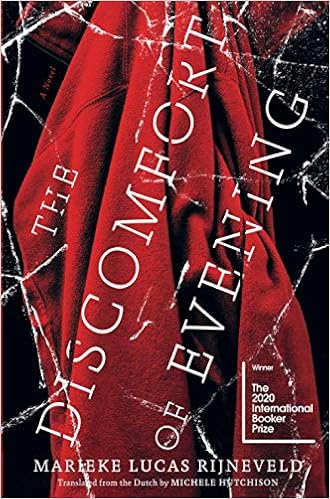3.5 Stars
The title can be seen as an understatement because a reader will experience more than just brief discomfort when reading this book. Opening the pages of the novel (the winner of the 2020 International Booker Prize) means entering a world of pain from which there is virtually no reprieve.
The Mulder family belongs to the strict Dutch Reformed Church. When the eldest son Matthies dies after falling through the ice while ice skating, the family falls apart. The parents retreat into silence so the remaining three children are left to deal with their emotions and confusion. Ten-year-old Jas, the middle child, is the narrator describing growing up in the aftermath of loss and unexpressed grief. Emotional turmoil is unspoken but becomes displayed in increasingly disturbing ways.
The mother starves herself, eating less and less, whereas the father grows more distant from his family. Jas comments that, “Mum and Dad are there, but at the same time they aren’t.” Jas’ mother avoids touching her and her father doesn’t see her: “He looks at the ground or up at the sky more than at the things at eye height. At my current size I’m right between those things, and I’ll either have to make myself bigger or smaller to be seen by him.” Jas remembers a comment: “According to our teacher, eye contact isn’t necessary for love, touch is more than enough. I wondered then what you should call it when both of them are lacking: eye contact and touch.”
Because the children are neglected, “Mum and Dad don’t see our tics. They don’t realize that the fewer rules there are, the more we start inventing for ourselves.” Unable to verbally express their emotions, they manifest them in physical terms. Obbe, for example, obsessively bashes his head against his bedframe and starts abusing animals. Jas sticks a thumb tack in her navel and develops chronic constipation. Forbidden to discuss their brother’s death, they try to understand the mechanics of death and what Matthies might have experienced by performing experiments on animals and each other. Though curious about death, they also fear it. They perform sacrifices to keep death away from the family. Anxious about when death might come for her, Jas (whose name means “jacket” in Dutch) refuses to take off her coat which she thinks of as her protective layer; in the pockets she stores “all the things I want to hang on to, the things I’m collecting to become heavier.” As time passes, their behaviour becomes more and more disturbed; cruelty and acts of violence express the pain and loss not mentioned.
Since Jas is the narrator, the language is appropriately plain. Childish similes abound: when cows are slaughtered because of foot and mouth disease, Jas describes a loader picking up the carcasses “like cuddly toys at the fair”; “I imagined the diarrhoea splattering onto the grass like the caramel sauce my granny poured onto the rice pudding”; when she blushes, “I feel my cheeks fill with colour like the circles after multiple-choice questions.” The subject matter reflects Jas’ age as well. As a young girl, she has limited knowledge of the world so often resorts to magical thinking: if her pet toads breed, then her alienated parents might once again become intimate. Like any pre-pubescent, she is fascinated by bodily functions and body fluids. She and her siblings also have a natural curiosity about sex but it does not develop in a healthy way. Since sex is a topic that is not discussed in the home, the children engage in sexual games and experiment with masturbation without recognizing what it is. At times the narrative is disjointed and episodic but this lack of cohesiveness is also appropriate to the narrator.
This novel is certainly not for everyone. It is dark and mournful. Scenes of torture and abuse are graphically described - I was reminded of the work of the Dutch painter Hieronymus Bosch. Readers should prepare themselves for an intense, unsettling book.

No comments:
Post a Comment